This week I’m going to be doing something a little different with Dear Azami. You see, I was faced with an interesting question in one of the submission emails, and I found that a straight deck doctoring wouldn’t necessarily give me an opportunity to answer the underlying question.
Here’s that email:
Dear Azami,
I’m a long time reader, and enjoy-er of the articles weekly. It is awesome to see all the different approaches and card choices to all sorts of commanders, but now I am the one in need of assistance. My girlfriend and I have 11 finished Commander decks and I pride myself on having made them all play quite differently and thematically with the commander in charge… that is, except for our attempt at Rakdos, Lord of Riots. In the process of doing the prismatic we were stumped on a unique direction for red/black since mono black had Chainer reanimation and sac effects, Rhys had tokens, and Doran as well as Godo showcased aggro. The problem being, none of the red/black commanders lent themselves to any strategies that we hadn’t already covered. Then after she opened a french pack of RtR and with it Rakdos, I realized a suicide-style strategy could be a fun approach.
Well here we are and the deck is a slight mish-mash of what I initially intended and some “good-stuffs.” I’m not really feeling the theme as much as I would like and I sadly kind of lost the love I had for the idea. Hopefully the column can help me to rekindle the love and keep the awesome theme, built around the namesake demon himself!
Thank you in advance!
Commander: Rakdos, Lord of Riots
Stuff that definitely doesn’t jive:
Diabolic Servitude
Incendiary Command
Terminate
Ashes to Ashes
Phthisis
Things to “cheat” in:
Zealous Conscripts
Tephraderm
Mindclaw Shaman
Tahngarth, Talruum Hero
Malignus
Bloodgift Demon
Kolaghan, the Storm’s Fury
Xathrid Gorgon
Netherborn Phalanx
Vein Drinker
Inferno Titan
Grave Titan
Deepfire Elemental
Defiler of Souls
Herald of Leshrac
Sheoldred, Whispering One
Sepulchral Primordial
Molten Primordial
Knollspine Dragon
Hateflayer
Stalking Vengeance
Kaervek the Merciless
Tsabo Tavoc
Pit Spawn
Furyborn Hellkite
Bogardan Hellkite
Avatar of Woe
Myojin of Night’s Reach
It That Betrays
Enablers & “Rampers”:
Lobber Crew
Plague Spitter
Warmonger
Thrashing Wumpus
Deathbringer Thoctar
Honden of Infinite Rage
Pyrohemia
Pestilence
Chandra, the Firebrand
Festering Evil
Manabarbs
Painful Quandary
Warstorm Surge
Random:
Vedalken Orrery
Hex Parasite
Mimic Vat
Mob Rule
Insurrection
Void
Blasphemous Act
Cauldron Dance
Ghastly Conscription
Beacon of Unrest
Profane Command
Rocks:
Sol Ring
Veinfire Borderpost
Rakdos Signet
Rakdos Keyrune
Lands:
Forgotten Cave
Barren Moor
Shadowblood Ridge
Command Tower
Shivan Gorge
Leechridden Swamp
Blackcleave Cliffs
Sulfurous Springs
Winding Canyons
Graven Cairns
Stensia Bloodhall
Badlands
Tainted Peak
Rakdos Carnarium
Blood Crypt
Temple of the False God
Lavaclaw Reaches
Dragonskull Summit
Molten Slagheap
Bloodstained Mire
8 Swamp
8 Mountain
Best regards,
Brent
I could do this as a straight upgrade of Rakdos, Lord of Riots. That column might even be moderately interesting, although it would be pretty straightforward. Cut the off-theme cards, which would be most of the non-creature spells, and replace them with draw engines to maintain your momentum and creature-based removal spells. But I’ve always been underwhelmed by Rakdos, Lord of Riots, and I don’t know that I think he plays in a particularly novel space for Rakdos decks. At the end of the day Rakdos, Lord of Riots is a ramp deck in the same way Animar, Soul of Elements is a ramp deck… but unlike Animar, Soul of Elements, Rakdos’s incidental aspects weaken him significantly.
To get Rakdos, Lord of Riots on the board you need to have either cheap creatures or direct damage spells, but neither of these things synergize particularly well with his cost-reduction ability. It’s a red and black aggro commander that has you casting your creatures in your second main phase. Rakdos, Lord of Riots decks are even more vulnerable to Wrath of God than most creature decks: you’re trying to vomit out your hand as fast as you can, which means you’ll be left with no gas in your tank and an uncastable commander. And just in case you thought it would be worth making it through all these challenges so you could get a four-drop aggro commander, Rakdos’s tetchy mana cost means you either have to invest a bunch of money into your manabase or play mana rocks… both of which somewhat eliminate the point of having a ramp commander.
There are interesting things you could do with this deck, sure. You could try copying Animar, Soul of Elements to create a morph commander deck that spits out morphs for free, but without access to Glimpse of Nature or Soul of the Harvest you’re going to have a hard time really going off. You could do some sort of Mycosynth Golem/Affinity Commander deck where the goal is to vomit out a horde of robots, but you’re trading Daretti, Scrap Savant or Slobad, Goblin Tinkerer for access to one copy of Cranial Plating… I can’t imagine that’s worth it. Finally, you could make a Pandemonium deck, but then your deck is built around a four- or six-mana set of enchantments that you not only will have difficulties ramping out early enough to be relevant, but that also you have no means of recurring when they get removed.
In short, while there are interesting things to do with Rakdos, Lord of Riots, that commander is deceptively terrible and doesn’t offer particularly novel options for a Rakdos-colored deck.
(Incidentally, talking about a Rakdos Rakdos deck is getting close to Buffalo buffalo buffalo territory.)
But there is a fun little archetype camped out firmly in the Rakdos color identity, and I find it plays just as entertainingly in Commander as it does in Limited. I’m referring to the “Steal and Sac” archetype, which was a particularly powerful deck in M14 Limited.
It’s pretty straightforward as these things go. Red has ways to steal creatures for short periods of time, and black has ways to make sure those creatures never go home. You’re basically replicating Slave of Bolas, but usually getting more of a benefit from the sacrifice half of the deck as well.
Maybe this is too close to a Chainer, Dementia Master sacrifice deck, but I think there are distinctions. The major distinction is whose permanents you’re sacrificing; in addition to that, this deck plays more controlling than a typical sacrifice deck. Your Act of Treason effects basically become spot removal with damage attached to them and the potential to draw a card here and there.
Rakdos, Lord of Riots isn’t the right commander for the Steal and Sac deck, and here’s what makes this deck really interesting. The best commander for this style of play is Tymaret, the Murder King, which means you’re playing a game of Commander with your commander going to the graveyard, not the command zone.
My apologies for the buffalo in that sentence.
Now, I could take Brent’s deck and carve it into a Tymaret, the Murder King Steal and Sac deck. I mean, several of the pieces are there: Cauldron Dance, Mob Rule, Insurrection, Zealous Conscripts all do interesting things when you’re playing this style of game. At the end, though, I’d be doing a disservice to Brent, and I’d probably be doing a disservice to the Steal and Sac archetype as well.
So instead I’m going to share with you one of my own lists, and then I’ll highlight different interactions and synergies that I happen to like. It’s not a perfect fit for the Dear Azami format, but I’ll get to share one of my favorite decks with you, and perhaps that will offer some insight into the type of decks I build when left to my own devices.
Here’s my list:
Commander: Tymaret, the Murder King
Bloodsoaked Champion
Gravecrawler
Pack Rat
Reassembling Skeleton
Bloodghast
Nether Traitor
Grim Haruspex
Ophiomancer
Squee, Goblin Nabob
Pyre Zombie
Stronghold Assassin
Undead Gladiator
Jaya Ballard, Task Mage
Vulturous Aven
Olivia Voldaren
Graveborn Muse
Necrotic Ooze
Risen Executioner
Veilborn Ghoul
Anarchist
Zealous Conscripts
Gray Merchant of Asphodel
Phyrexian Plaguelord
Puppeteer Clique
Sidisi, Undead Vizier
Harvester of Souls
Conquering Manticore
Mikaeus, the Unhallowed
Sepulchral Primordial
Molten Primordial
Greater Gargadon
Skullclamp
Sol Ring
Tortured Existence
Altar of Dementia
Goblin Bombardment
Ashnod’s Altar
Kolaghan Monument
Phyrexian Altar
Phyrexian Vault
Rakdos Cluestone
Rakdos Keyrune
Rings of Brighthearth
Mark of Mutiny
Kolaghan’s Command
Phyrexian Arena
Underworld Connections
Harness by Force
Traitorous Blood
Dark Prophecy
Trading Post
Lose Calm
Outpost Siege
Portent of Betrayal
Traitorous Instinct
Dread Return
Whip of Erebos
Act of Aggression
Palace Siege
Mass Mutiny
Mob Rule
Volcanic Vision
Akoum Refuge
Arcane Lighthouse
Auntie’s Hovel
Barren Moor
Blackcleave Cliffs
Bloodfell Caves
Bojuka Bog
Command Tower
Crypt of Agadeem
Dragonskull Summit
Forgotten Cave
Graven Cairns
Grixis Panorama
Jund Panorama
Kher Keep
Lavaclaw Reaches
Molten Slagheap
3 Mountain
Nykthos, Shrine to Nyx
Opal Palace
Rakdos Carnarium
Rakdos Guildgate
Rix Maadi, Dungeon Palace
Spinerock Knoll
Springjack Pasture
Sulfurous Springs
7 Swamp
Urborg, Tomb of Yawgmoth
Urza’s Factory
Now that I’ve shared my list, let’s go a little deeper into the individual card choices.
The Commander
Tymaret, the Murder King has more play than you would think at first glance. Its most obvious role is as a hard-to-remove sacrifice engine. It comes down turn two, it’s functional whether it’s on the battlefield or in the graveyard, and even if they do manage to exile it you can just recast it for cheap.
On another level, Tymaret, the Murder King lets you convert creatures on the board into creature cards in your hand. That sounds like a pointless ability since so much of Magic is concerned with moving in the opposite direction, and yet you can build around it. Tortured Existence, for example, lets you pay 1BB and sacrifice a creature to Raise Dead as many times as you want. Jaya Ballard, Task Mage lets you pay 2BR and sacrifice a creature to Incinerate every turn. It’s not the strongest synergy, but when you add in cards like Necrotic Ooze it starts getting pretty hard to disrupt.
Also, he’s a burn commander! On top of all the other things he can do, he does a reliable two points of damage to the face. While it takes a while for those triggers to add up, it basically means you can exert control over anyone at a low life total since you don’t have to attack past their shields to kill them. Tymaret just lobs his fodder over the walls, and sometimes that fodder is the corpse of your opponent’s best creature. Incidentally, that sequence of plays often reminds me of Achilles and Hector, which is fitting given the source material for Theros Block.
Finally, it’s a commander that can give you death triggers. This shouldn’t be as big a deal as it is, but the one weakness of the command zone is that any commander who goes back there technically doesn’t die. If you have something that triggers off the death of a creature, like Dark Prophecy, your commander is usually unable to trigger the effect. This changes radically when your commander has the ability to claw itself out of the graveyard, and playing a game where your commander can get binned without consequence is shockingly enjoyable.
The Lands
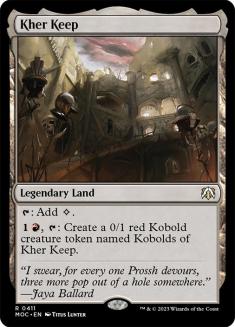
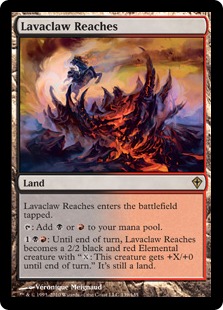
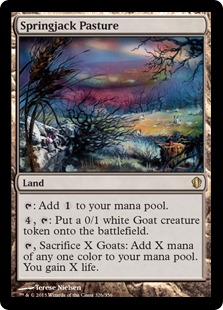
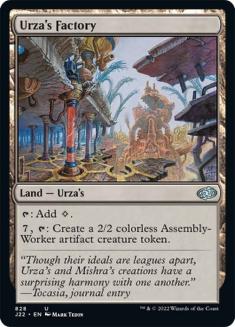
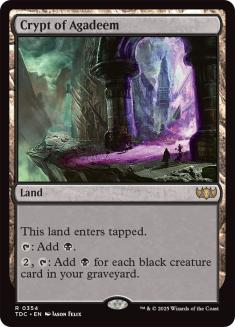
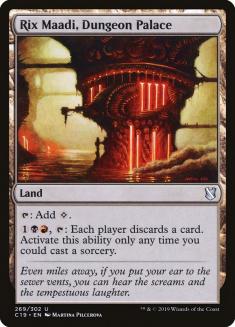
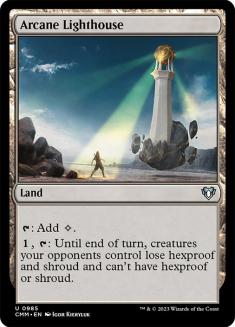
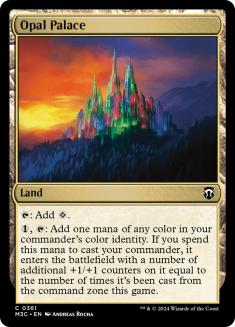
First, I’d like to point out I’m running 37 lands. Shocking, given how big of a proponent of 38 lands I’ve been, but here I make up for it with a surplus of draw engines. This deck rarely has issues hitting its land drops, and that’s important when you have so many things to do.
While I’m certainly playing a lot of duals (and yet not Badlands, or even particularly bad lands), the interesting cards are the lands that do something. First, there are the lands that have or generate bodies. Kher Keep makes Kobolds, Springjack Pasture makes Goats, Urza’s Factory makes Assembly Workers, Lavaclaw Reach becomes an elemental, and none of that really matters. What matters is that they are bodies that can be sacrificed for value.
Crypt of Agadeem is usually pretty weak, because most of the time you’re not going to have four black creatures in your graveyard (the point at which it becomes net positive). However, it’s a great way for a deck like this to rebuild after a Day of Judgment, and in a pinch it can convert red or colorless mana into black.
Rix Maadi, Dungeon Palace is kind of a mean card, like most discard strategies, but it lets you fill your graveyard. Sometimes that means you get value off a card like Squee, Goblin Nabob, but its main role is to let you get Tymaret out of your hand without having to cast it. Arcane Lighthouse is for the Asceticism decks, where you need a way to get around hexproof or shroud.
Finally, there’s Opal Palace. It may seem ridiculous in a deck like this because you’re so rarely playing your commander from the command zone, but it’s surprisingly powerful. Not only is it fixing for a commander with a very specific mana cost, but it also means the difference between a 2/2 commander and a 3/3 commander, because the effect adds a counter whether or not you’re casting it from the command zone. While Tymaret, the Murder King rarely kills through commander damage, the difference between eleven turns and seven turns is a big difference in the few games where you might have to rely on that particular kill condition.
The Steal
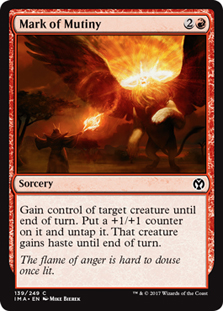
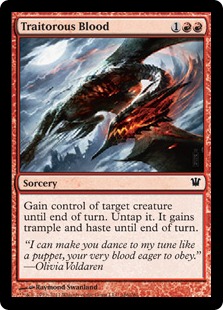
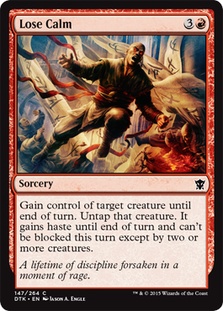
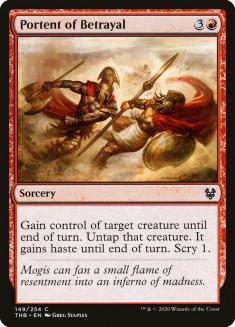
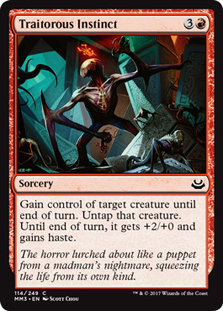
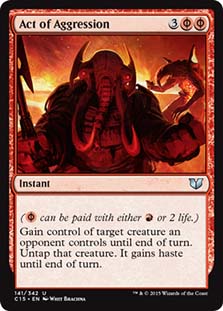
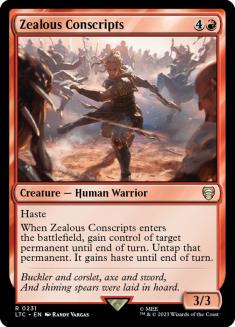
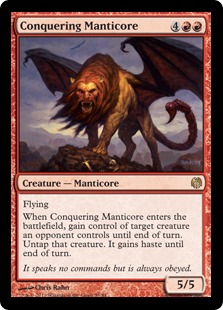
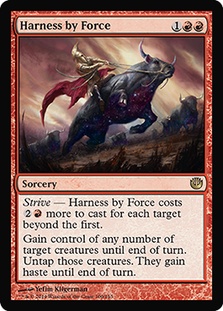
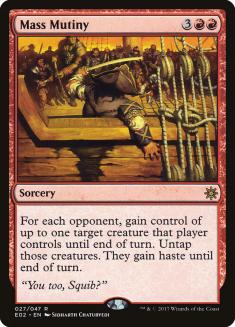
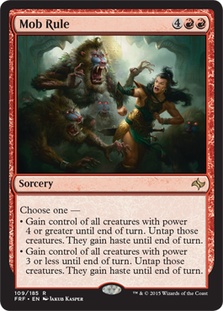
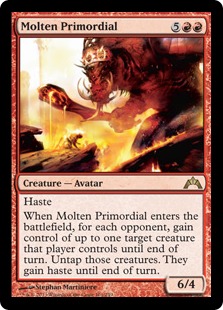
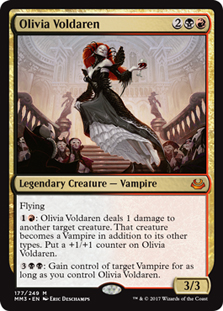
Notably absent from this section? Insurrection. I dislike playing with that card because it doesn’t really need help from anything else to win the game. Restricting myself to stealing most of the creatures has been a fairly effective way of making sure the deck does what I want it to, which is grind.
My larceny comes in two degrees: one target or multiple targets. The single-target spells all have some ancillary benefit to them, although it’s usually fairly marginal. Mark of Mutiny and Traitorous Instinct pump, Traitorous Blood gives trample, Lose Calm gives menace (I’m loving that, by the way), Portent of Betrayal lets you scry, Act of Aggression is instant speed, and Zealous Conscripts and Conquering Manticore both come attached to somewhat-relevant bodies. So they’re one-for-ones, but they’re interesting one-for-ones.
The multiple ones are all pure card advantage. The weakest, Harness by Force, offers flexibility (if at a relatively expensive price). Mass Mutiny and Molten Primordial both let you take the best creatures from your opponents’ boards, and force them to make the attacks you wish they would make on their own. And Mob Rule is just a slightly-less-broken Insurrection, which is still pretty broken.
Olivia Voldaren is the most interesting, though. This deck, for reasons that should become apparent, is a strong Necrotic Ooze deck. Adding Olivia Voldaren to the mix not only feeds into that synergy, but it also means that should you flood out with seven or more mana in play, you have a way to translate that into action.
Plus, she’s a great card to play with in Commander. A heck of a lot of fun, I’d advise giving her a spin if you haven’t had the opportunity.
The Sac
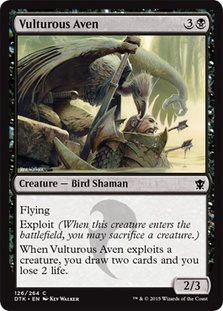
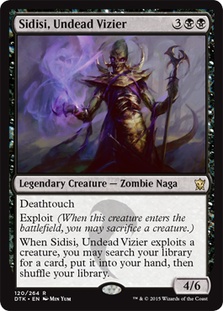
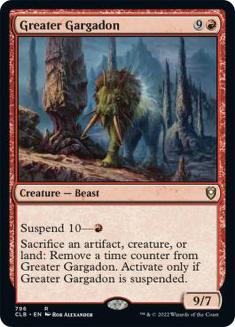
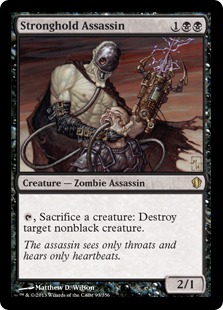
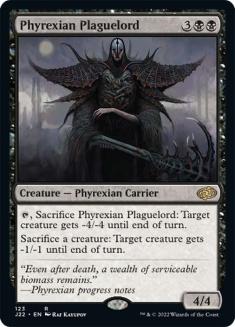
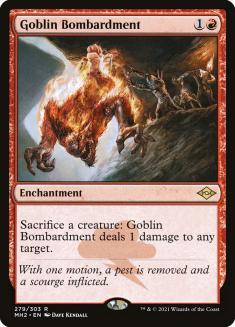
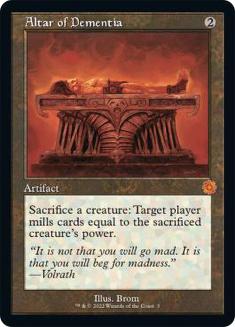
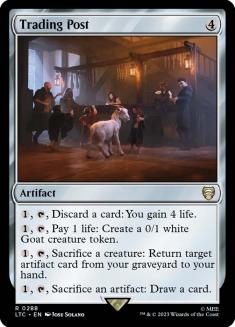
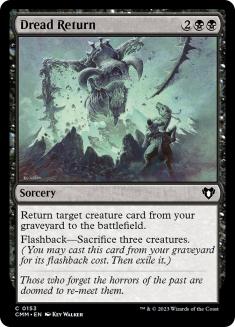
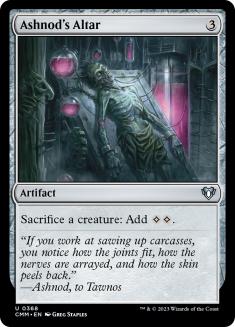
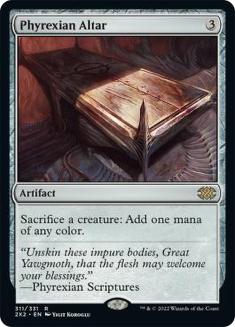
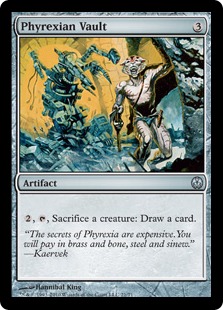
As soon as the exploit mechanic was spoiled I thought of this deck. In the end, the black ones didn’t all hit the power level I was hoping for, but “draw two cards” and Demonic Tutor proved powerful enough to make it in, my long-standing issues with tutors aside. Maybe if I was playing Standard these days I’d be more okay writing off Sidisi, Undead Vizier, but I’m not, and sometimes I include cards in decks because I want to have the opportunity to play with the card.
Greater Garagdon excels against blue decks, because it’s a sacrifice engine that’s nearly impossible to counter.
Stronghold Assassin and Phyrexian Plaguelord let you sacrifice creatures to kill other creatures, while Goblin Bombardment and Altar of Dementia let you sacrifice creatures to kill players.
Trading Post and Dread Return let you sacrifice creatures to recur things from your graveyard, which is particularly good if you ever have need to point Altar of Dementia at yourself. Phyrexian Vault similarly turns sacrificed creatures into cards, although the vault gives you novel ones.
Finally there’s Ashnod’s Altar and Phyrexian Altar. The altars are ramp cards, free sac outlets that boost your ability to do things. There are times were you steal something, sacrifice it, and then have mana to steal something else. It’s a pretty fun sequence of plays!
Synergies
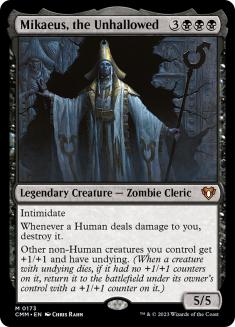
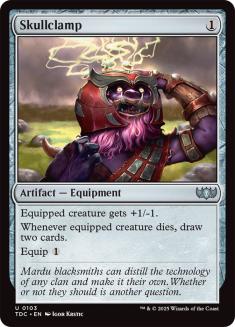
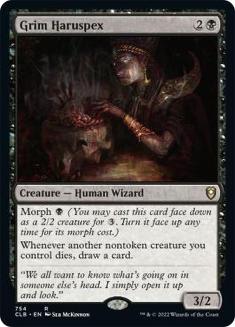
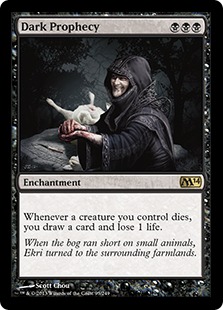
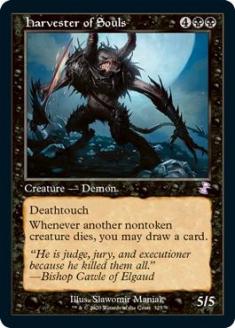
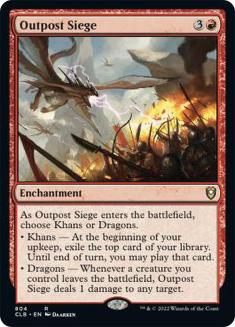
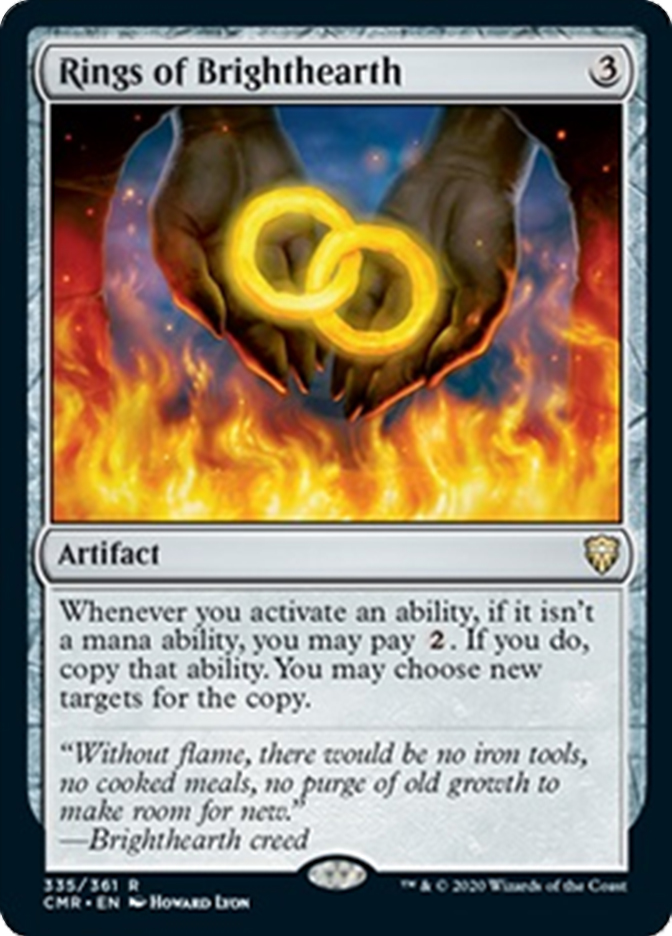
The deck wouldn’t be nearly as good were it not for the cards that take advantage of the other sacrifice effects. None of these cards have the Ruthless Deathfang phrasing, or even mentions sacrificing at all, but they still synergize really well with what the deck wants to be doing. Grave Pact would fit well into this section, if it weren’t a funkiller/aggro magnet. As is, Mikaeus, the Unhallowed is a bit iffy. If it’s out and you sacrifice an opponent’s creature, that creature will come back on your opponent’s board stronger than ever. It also means I can’t run Murderous Redcap, because I eschew combo kills when able. It’s a shame; Murderous Redcap would be a great addition.
If I have a weakness in Commander, it’s that I love drawing cards. I’m a sucker for a Skullclamp, since it means you get two practically free cards off every one of your sorcery-speed sacrifices. Grim Haruspex, Dark Prophecy, and Harvester of Souls all take the “practically” out of that sentence, letting you net a free card off each of your sacrifices… with minor qualifiers to “free” and “each” for Dark Prophecy (life) and Grim Haruspex (nontoken) respectively.
Outpost Siege is a particularly fun card, though. If you’re in a hole, you can play it as a draw engine to help dig you out. If you’re in a solid position, you can play it for its “Dragons” side. Then, every time you sacrifice a creature, you get a free point of damage to direct wherever you want it. It turns every Goblin Bombardment activation into Forked Bolt, basically, and that’s a really powerful synergy.
It gets even more powerful with Rings of Brighthearth. This deck has a number of activated abilities in it. At the base level, the Rings of Brighthearth are there to turn Tymaret’s ability into a four-mana, four-damage activation; that it synergizes with everything from your sacrifice engines to your draw and removal permanents is just icing on the cake.
Fuel
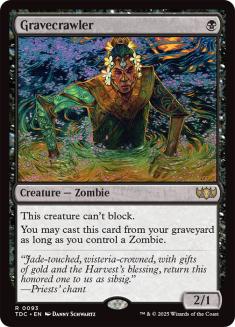
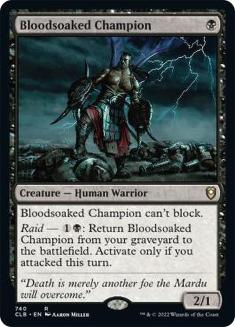
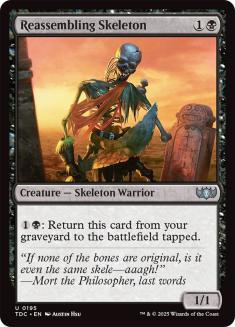
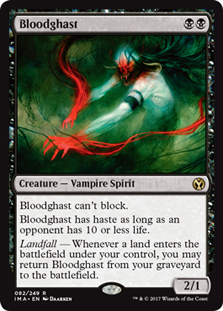
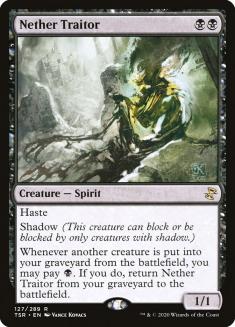
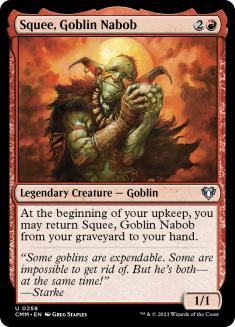
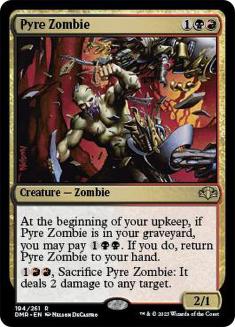
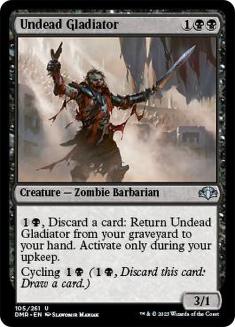
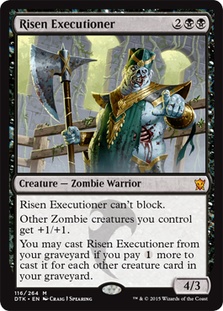
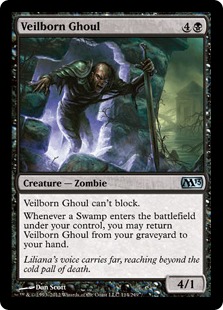
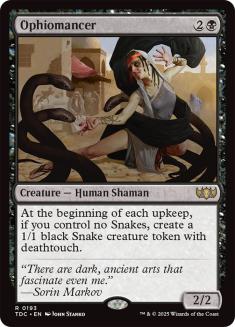
Of course, some times the “steal” part of “Steal and Sac” needs some grist for the mill. Having cheap recursive creatures to sacrifice helps with that. Some of them, like Bloodsoaked Champion, Reassembling Skeleton, Bloodghast, and Nether Traitor pop back into play after you’ve sacrificed them for a variety of different costs and conditions. Nether Traitor, for example, is a cute way to add a second sacrifice whenever you kill something of your own.
Others are about getting those cards in hand. Squee, Goblin Nabob comes back on his own (whether or not he’s wanted… Squee seems like a sad combination of CL4P-TP and Zoidberg, from what little I know of that period in Magic’s history). Pyre Zombie is basically the most expensive version of this effect, while Veilborn Ghoul may be the most easily-overlooked recursive creature since Ashen Ghoul, a card I tend to avoid because maintaining graveyard order is annoying.
Risen Executioner might be a little cute; I’ve yet to have much experience playing with it. It’s in there to be similar to a Gravecrawler, a card you can cast from the graveyard when you don’t have a better play in hand. It replaced Haakon, Stromgald Scourge when Dragons of Tarkir came out, but I’ll probably bring Haakon back in at some point. Losing two life upon its death is a significant drawback, but not an insurmountable one.
Finally, there’s the oft-overlooked Ophiomancer, a must-have in any deck like this. It’s even good in a Rakdos, Lord of Riots deck! Here it provides an unending wave of snakes to sacrifice; in a Rakdos deck, it gives you an attacker that can usually sneak through someone’s defenses to get that first point to turn your deck on.
Engines
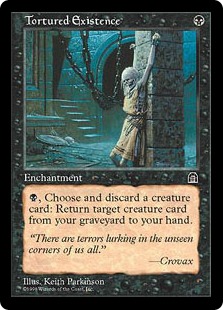
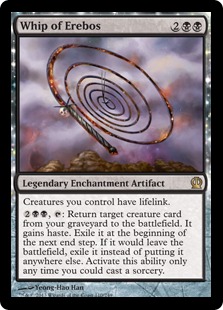
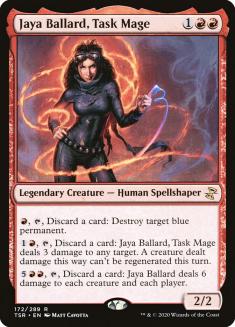
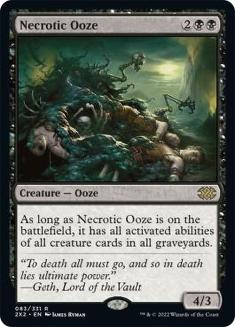

I’ve mentioned Tortured Existence above, but what it comes down to is that it’s black’s version of Survival of the Fittest. When you can keep reloading your hand with creature cards, it turns out to be a very powerful ability.
Whip of Erebos has a bit of a resource cost to it, since you can’t then recur any creature you whip onto the battlefield, but the static lifelink ability goes wonderfully with Tymaret’s direct damage mode.
Jaya Ballard, Task Mage turns all those creatures in hand into action on the field. Usually her base ability is Incinerate, but every once in a while you’ll find her absolutely devastating a blue opponent with her Pyroblast-esque ability.
Pack Rat also turns cards in hands into resources on the board while giving you a way to dump Tymaret, the Murder King back into his undercroft.
Both of these cards find their power amplified when Necrotic Ooze steals their abilities. There are truly few things as terrifying as Necrotic Ooze tokens, and the spot removal offered by the Steal and Sac modus operandi means you can give it any cool ability that someone else has on the battlefield. It can be a Phyrexian Plaguelord, a Stronghold Assassin, or Olivia Voldaren. It is everything with the right support, and nothing without it. In short, it’s an amazingly fun card to actually play with, so long as you’re not using it for an instant combo kill.
It does those pretty well, though.
Conclusion
I don’t want you to think I’ve totally abandoned your Rakdos, Lord of Riots list though, Brent. If you are interested in sticking with that theme, I put together a few suggestions for cards to add to the mix:
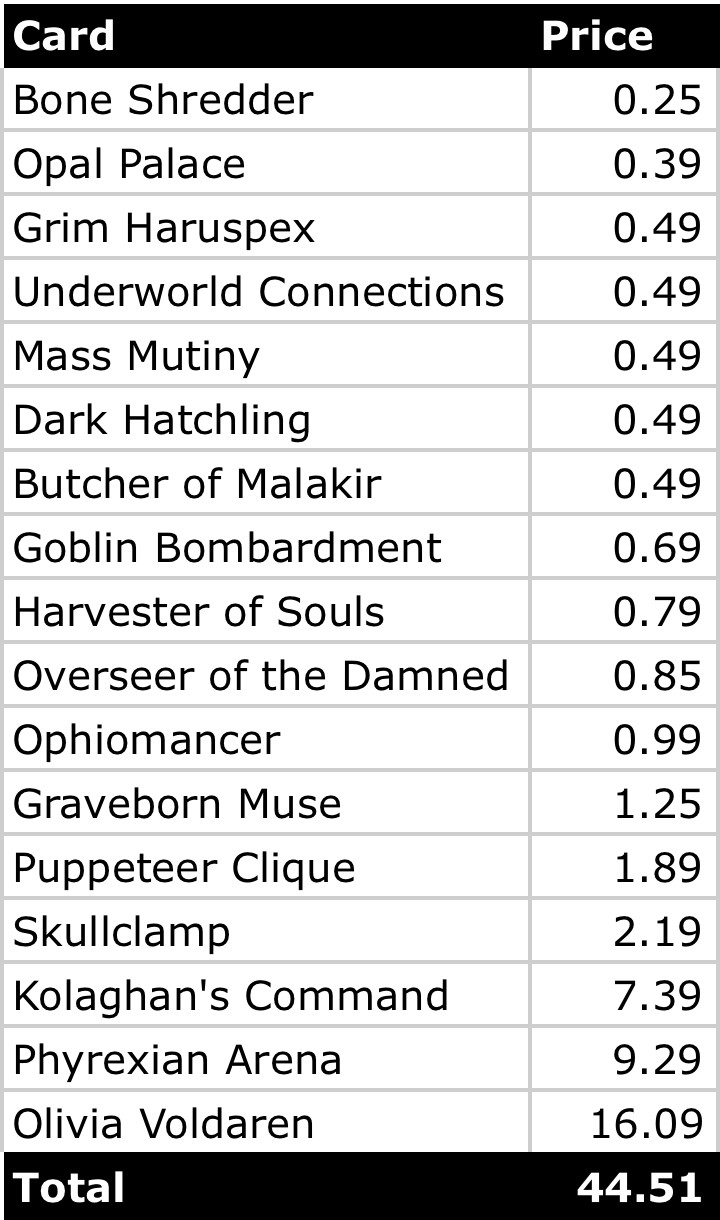
Many of these cards were discussed above, and a few need little explanation. Basically, you want to keep drawing cards with Rakdos so you can play more creatures when you get a big hit in, and it helps if those creatures also do something to advance your board position. Cards like Bone Shredder and Dark Hatchling are great because their evasive bodies help trigger Rakdos’s entrance music; Puppeteer Clique plays a similar role while also letting you clean out a graveyard by throwing your opponents’ dead creatures back in their face.
And while I am personally not a huge fan of Grave Pact effects, Butcher of Malakir is the type of top-end card you want to be cheating into play. Overseer of the Damned is another good one, because it kills something else when it enters the battlefield, and it generates a zombie horde you can throw at an opponent’s shields to get some damage through.
The real benefit of the cards listed above, though, is that they’re fairly universally playable cards in Commander. Even if you eventually find yourself abandoning the Rakdos color identity, you can strip these cards out and slot them easily into a host of other decks. Graveborn Muse is a great draw engine whether you’re running zombies or not. Underworld Connections is another great draw engine that’s currently cheap as can be: compare it to Phyrexian Arena to get a sense of how much that price could grow over time.
These cards are useful, powerful, and fun. It’s probably worth cutting sub-optimal cards like Hex Parasite and Painful Quandary to make room for some of these role-players.
I think you’ll like the result, and I hope everyone enjoyed this brief diversion from the traditional Dear Azami format.
Want to submit a deck for consideration to Dear Azami? We’re always accepting deck submissions to consider for use in a future article. Only one deck submission will be chosen per article, but being selected for the next edition of Dear Azami includes not just deck advice but also a $20 coupon to StarCityGames.com!
Email us a deck submission using this link here!
Like what you’ve seen? Feel free to explore more of Dear Azami here, in the Article Archives! And feel free to check Jess’s own Command of Etiquette column on Hipsters of the Coast, for more Commander and casual content. Now on Thursdays!
